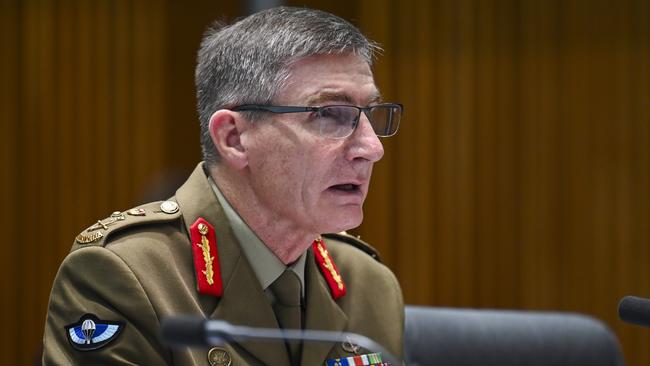Anzac frigate’s future in doubt as workforce crisis bites
A mothballed Anzac-class frigate could soon be junked as Defence struggles to cope with a shortfall of more than 4300 personnel.

Defence has revealed a mothballed Anzac-class frigate could soon be junked as it struggles to cope with a shortfall of more than 4300 personnel.
Chief of the Defence Force Angus Campbell laid bare the extent of the ADF’s chronic workforce crisis in a Senate estimates hearing, revealing it was nearly 7 per cent under strength and was continuing to shrink.
“Inflow rates remain below the level required to maintain our current force,” he said.
General Campbell said personnel shortages had placed “stress across the entire organisation”, and were most acute for technical roles.
Chief of Navy Mark Hammond said the service could now muster only 4½ crews for its eight workhorse frigates, and suggested first-of-class ship HMAS Anzac might now not undergo planned life-extending upgrades.
The Australian revealed in November the frigate had been taken out of the water indefinitely, amid shortages of engineers and a cloud over the Anzac upgrade program.
Vice Admiral Hammond told senators he had ordered an assessment of the ship, which was suffering “drive train fragility issues” after 27 years of service.
He said the study would “inform a value-for-money assessment of retaining her for an extended period”.
The move comes ahead of the release of the government’s new surface fleet plan next week, which is expected to confirm the troubled Hunter-class frigates program will continue, and potentially announce a new fleet of corvettes for the navy.
Defence officials revealed the army was currently 2891 personnel under strength. The navy has a deficit of 881 personnel, while the air force is short 534 people.
The personnel crisis comes as the government scrambles to re-arm and reform the ADF to prepare for a feared conflict between China and the US over the status of Taiwan sometime in the next decade.
General Campbell blamed the difficulties on low unemployment rates, and said “considerable effort and innovation” was going into addressing the issue. He said Defence was considering allowing “non-citizen enlistment” as one option, with Australian citizenship being offered as a lure for potential foreign recruits.
The personnel shortage was making it hard for the ADF to do its job, General Campbell said, with the pressure to “fill the hole” requiring that more personnel be dedicated to recruiting, induction and training.
Despite the shortfall, officials said the ADF’s workforce costs had gone up by more than $900m a year due to a range of factors including retention bonuses, increased health costs, moving costs and housing.
Defence chiefs were also grilled over the army’s retired MRH-90 Taipan helicopters, amid criticism they were not gifted to Ukraine. The army’s head of joint aviation systems, Major General Jeremy King, told senators that work to strip parts from the aircraft began almost immediately after the fleet was retired last year, and they could not be made airworthy again.
“We have not had an airworthiness framework around those airframes for nearly five months,” he said. “And that is a boring but important nuance in relation to how we manage these aircraft.”
The Chief of Army, Lieutenant General Simon Stuart, said the aircraft’s $45,000-plus per hour flying costs and poor availability record made them inappropriate for the casualty evacuation role Ukraine wanted them for.
“It is not suitable for that task. You need to have a reliable aircraft for that task,“ General Stuart said.
The army achieved only a 40 per cent availability rate for the aircraft due to long-running sustainment issues. But opposition senator David Fawcett said the New Zealand army achieved a far better rate of 70 per cent.




To join the conversation, please log in. Don't have an account? Register
Join the conversation, you are commenting as Logout